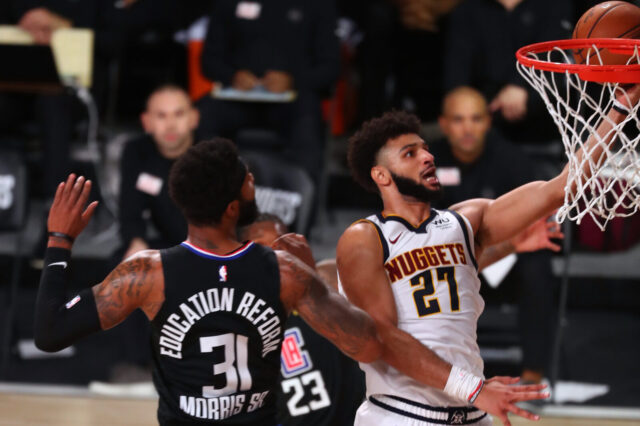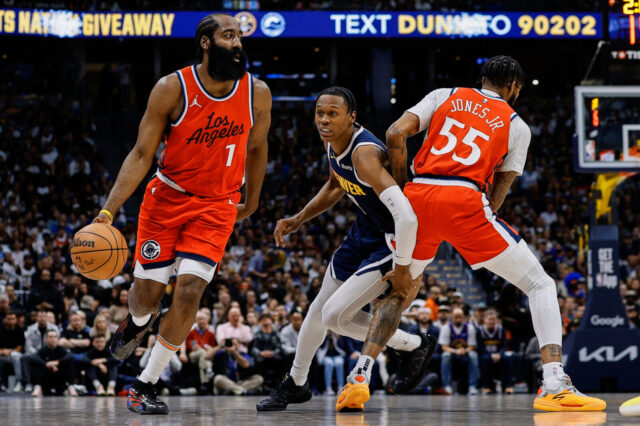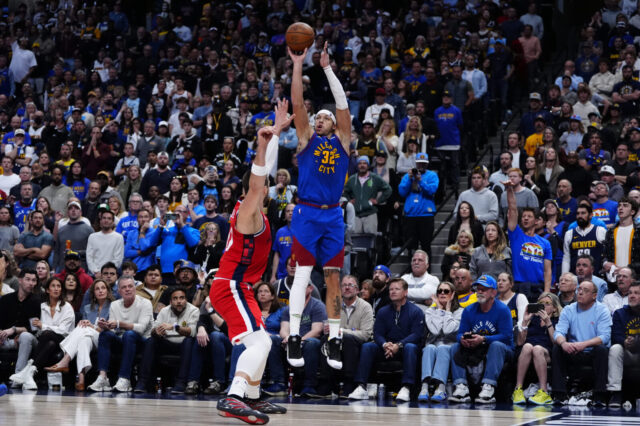Disguising the post up
The Denver Nuggets have struggled to get the ball into the post this season. It’s actually been an issue for the Nuggets dating all the way back to last year (and beyond), perhaps most notably in the final game of the season when Nikola Jokic was forced deep into the corner on what should’ve been the final play of regulation. The play call was to get Jokic the ball on the block. An inability to hold position on the block was compounded by an inability to throw a proper entry pass and the result was Jokic isolation deep in the corner and ultimately fumbling the ball out of bounds.
Similar things have happened this season. Just watch how much Jokic struggles to gain an advantage as he jockeys for position against Gorgui Dieng.
Jokic likes to grab and flail on plays like this one, attempting to draw a foul against defenders who front him in the post. Referees fall for his antics somewhat frequently and defenders have a tendency to get annoyed and retaliate by doing something stupid and picking up a legitimate foul, but Jokic goes to this well a bit too often and on plays like this one, he gives the entry passer a difficult target.
But difficult or not, the Nuggets have really struggled with throwing the ball into the post, especially on possessions like this one where the post up is so obviously the direction of the play.
“We work on post feeding because it’s a lost art,” Nuggets head coach Michael Malone told reporters last week. “Obviously a lot of teams don’t post a whole lot anymore but a lot of guards don’t have any idea how to get the ball into the post. Using a dribble to get a better angle. And then on the flip side of that, the big has a responsibility to hold his position and seal his defender off and not release and let that guy circle the post for a steal.”
While the post entry pass is still a work in progress for most of Denver’s perimeter players, against the Trail Blazers the team used this nice disguised pindown action to get Jokic a clean pass into the post.
The play didn’t work out but the action is an example of using one of the team’s tendencies as a misdirection for a new action. The Nuggets run this double pindown action a lot, typically as a play designed to get the guard in the corner running off of a double screen. Here, the pindown begins like that but watch how Jamal Murray actually aims his screen at the center defending Jokic, allowing Jokic to release for a curl over toward the left block.
The action creates just enough of a delay for the Nuggets to get Jokic the ball in his favorite spot.
My favorite post move (kinda)
Mason Plumlee has started to integrate my favorite post move into his offensive arsenal.
Kind of.
Back when I was still schooling youngins in the post with dream shakes and fallaways, my favorite go-to move was the reverse pivot up-and-under. Similar to the regular up-and-under, a move used most perfectly by Kevin McHale, the reverse pivot up-and-under starts with a fake jump hook, usually going toward the center of the floor. As the defender lifts his body (either a jump to block the shot or just an extension to challenge the shot), you reverse pivot and seal the defender for the easy bucket.
When done properly, it’s one of those moves that makes the defender look like a fool and creates enough space to leave him in the dust. I learned the shot from Kobe Bryant, the best I’ve ever seen at this particular move. Kobe would often take this shot from much further from the basket but it’s a move that translates even better into the post.
Plumlee has developed an interpretation of this move but, as you might expect, it looks a bit more robust than the one Bean used to use. Still, it’s been effective at creating space. He could probably stand to square his body a bit better on the initial fake, that way he has a shorter distance to pivot back to on the reverse. Nonetheless, one of the benefits of this great move is that it finishes off of two feet. So if the move doesn’t work, the post player still has a pivot foot active to escape.
So who did it better? Mamba? Or Plumdog?
Timing on the DHO out of a reversal
The timing of a cut or action is often as important as the action itself. This is especially true of ball reversals in a free-flowing offense since every break in the action is a chance for the defense to get resettled and catch their bearings. In the clip below, Gary Harris elects to wait in the corner for Jokic as he dribbles toward him for a dribble handoff (DHO).
I’m not exactly sure why Harris decides to delay his sprint toward the ball. DHOs in the corner are difficult to defend so perhaps Harris was wanting to bury his man as a way to force the switch but to me this looks like a perfect opportunity to keep the defense guessing by sprinting into the handoff. Had Harris started his cut as soon as Jokic turned his direction, he could’ve had at least three steps of momentum before connecting for the handoff.
That momentum would’ve made him even more difficult to predict since he would have space to cut backdoor on a dime, leaving his defender in the dust. But more importantly, a quick reaction would’ve kept the entire defense operating under tight decision windows. As it worked out, all five defenders were able to survey the court and catch their bearings. These types of delays have become somewhat common for Gary Harris and I’m not sure if it is by design or by accident. Either way, I think he’d do better to speed up these handoffs when the ball reverses from one side of the court to the other.
Juancho Hernangomez’s fake rebounding
Juancho had this hilarious play in the 3rd quarter against Portland. He acts like he is going to run back on defense and not attempt to rebound the ball but it is all a decoy!
I don’t know why this is so funny to me but it is.


